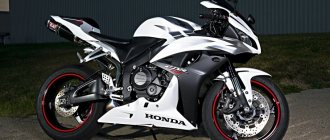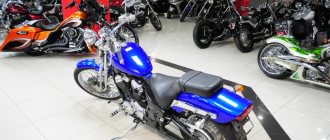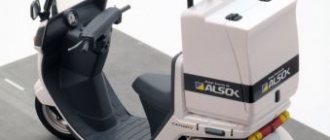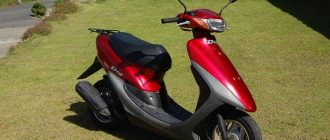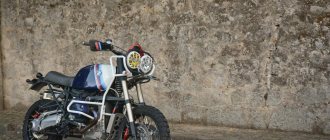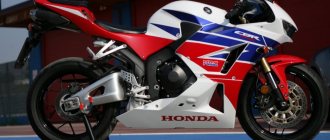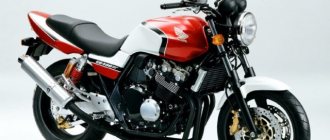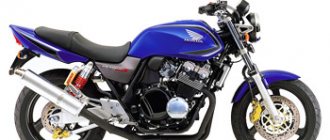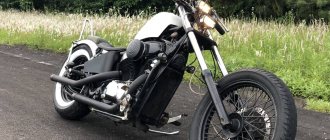On November 17, 1906, the son of a poor Honda blacksmith, Soichiro, was born. His early attraction to technology provided a confident direction for his future. After graduating from school, he moved to Tokyo to work as a car mechanic. Over six years of practice, he gained a lot of experience and managed to save a small amount to open his own small workshop. A young mechanic well versed in technology not only repaired, but also improved the equipment. So in 1928 he received his first patent. Replacing the wooden spokes in the wheel with metal ones. In 1938, he patented his invention, thanks to which he became known to the world. This was the installation of a compression ring on the piston. This continued until its production was bombed during the war. He had to sell what was left and get another job. Experiencing financial difficulties, he did not have enough money for a car. To save money, he attached a motor to his bicycle. Having made several of the same ones at the request of friends, he begins production of mopeds. Founding Honda Motor Company in 1948. Today the concern Honda Motor Co. - the world's largest manufacturer of motorcycles, covering all classes of motorcycles and is the undisputed leader.
In post-war times, getting from one place to another in Japan was difficult. For this reason, the first attempts to create a motorcycle began to appear at Honda. In 1946, the head of the company bought an abandoned building and created the Honda Research Institute there, which was later renamed the Honda Motor Company. This division produced the first full-fledged Honda motorcycle in 1949. Honda motorcycle technology in Russia began to gain popularity by 1961, when the Japanese manufacturer managed to produce at least 100,000 motorcycles per month.
Honda Shadow Motorcycle Series
The Honda Shadow line of motorcycle equipment has been produced since 1983. All motorcycles in this series are outstanding representatives of cruisers.
Technical characteristics of Honda Shadow
Honda shadow motorcycles have excellent characteristics for any motorcyclist who loves motorcycle travel. Almost all representatives of this line of motorcycles are equipped with only V-twin engines. They are liquid cooled. The volume ranges from 400 to 1000 cubic meters. cm.
Each Honda Shadow motorcycle has a cylinder arrangement at an angle of 52 degrees.
Shadow motorcycle range
Since 1989, the following motorcycle models began to appear in the line of motorcycles, including: Honda shadow 1100, shadow vt500, vt700, vt750. In 2011, a 750 cc cruiser remained in the lineup.
Honda Hornet Motorcycle Series
In 1998, the first representative of the Honda Hornet line of motorcycles first appeared on the market. The new CB600F has become a true classic.
Technical parameters of Honda Hornet
Honda Hornet motorcycles have quite acceptable characteristics for city riding. They have been the most influential in the middleweight division for a long time. The design contains sharp lines that are still relevant today.
Fuel consumption is optimal for a city motorcycle. Over time, the Honda Hornet motorcycle has undergone only minor changes, which affected the installation of 17-inch wheels. In 2003, the fuel tank capacity was also increased in the motorcycle line.
In 2007, the Honda Hornet motorcycle appeared before motorcycle fans in an improved guise.
Honda Steed motorcycle series
The Honda brand began producing its stylish cruisers in the Honda Steed lineup in 1993. These choppers were created in a unique American style, which attracted the attention of motorcyclists all over the world.
Parameters of motorcycles of the Honda Steed line
The motorcycles of this model range are distinguished by their sporty elegance. Honda Steed motorcycles have excellent characteristics for city riding. The true classics of the model range are the representatives of the 400 and 600 series. These retro motorcycles have a 31 horsepower engine. The engine type used was 4-stroke. Every Honda Steed motorcycle has a steel frame.
Today, only Steed 400 motorcycles are presented on the market in two trim levels. Gradually, in 1997, Honda stopped producing the Honda Steed 600 motorcycle.
First generation 1996-2001 RF1-RF2
In 1995, the Honda StepWGN minibus was presented at the Tokyo Motor Show. Honda consciously moved towards building a family car; in 1994 it released the CRV, in 1995 the Honda Odyssey, and in 1996 the Stepwagon began to be produced. The machine concept is functionality, performance and reliability.
The Stepwagon can accommodate both 5 and 8 passengers. A low floor with a high roof made the car comfortable and spacious. At that time, Japanese cars of this class had engines under the driver’s seat, but Honda began installing the engine using a classic layout, which helped reduce the price.
To reduce costs, one single choice of engine and gearbox was offered. This is an ultra-reliable 2-liter B20B, complemented by a 4-speed automatic transmission.
The Honda Stepwagon has a front-wheel drive and all-wheel drive, all-wheel drive like on a Honda Partner, works with the DPS system (a system with 2 pumps), the principle of its operation was that by default the torque was transmitted to the front wheels, but if they could not cope, then the torque was also transmitted to the rear ones.
The chassis of the StepWGN is quite interesting, with a MacPherson strut at the front and a multi-link suspension at the rear. In subsequent years, many Honda vehicles had the same design.
The Honda Stepwagon was a success in the Japanese market, and improvements were not long in coming. A year later, ABS and two airbags were standard, and many other useful features were added.
The seats recline comfortably and you can stay overnight quite comfortably
The seats can be assembled and the volume of the luggage compartment will increase
In 1997, ABS stability control and two SRS airbags were included, and many features were added.
In 1999, a deep restyling took place, the “face” changed, the bumpers and headlights were replaced. The unit became more powerful by 10 horsepower and produced 135 hp.
There was also a rare version of the Honda Stepwgn with a tent (with a folding roof), you can get into the tent from the cabin through a hatch, there are 2 of them.
In 2001, production of the model ceased.
Specifications
• Manufacturer: Honda • Production: 1996 – 2001 • Drive: front and 4WD • Transmission: 4-speed automatic • Unit: B20B, 125 hp 184 Hm • Length: 4,705 • Width: 1, 695 • Height: 1, 815 • Wheelbase: • Curb weight: 1410-1645 kg (dimensions in mm)
Price
Prices for a minivan start from 280 thousand rubles and can reach up to 400 thousand rubles. The engine and gearbox are quite reliable units; when purchasing, you should pay attention to the body, especially the arches. Spare parts are mainly purchased under contract, since the car was not officially delivered to Russia, and besides Japan, the Stepwagon was not officially sold anywhere and therefore there is no analogue with left-hand drive.
Photo taken from the portal Drom.ru
Maintenance tips and technical regulations
Maintenance tips and technical regulations are taken from the website Hondavodam.ru
• It is advisable to change the engine oil before 10,000 km. mileage (includes 4 liters) • Change the gearbox oil every 40,000 km, it goes there - ATF DW-1 (from 2.5-3.2 liters) • Power steering fluid - PSF, about 1 liter. • Fluid in the rear gearbox (only for 4WD configuration) - DPSF, more than one liter. • To replace antifreeze you will need a little more than 4 liters, for a partial replacement - less than 4 liters. Replacement interval: once every 2-3 years. • Spark plugs are changed every 20,000 km. • Timing belt: belt life 100,000 • Timing tensioner roller: 100,000 • Crankshaft face oil seal: 100,000 • Second camshaft oil seal: 100,000
(Use original Honda fluids; service regulations are taken from the website Hondavodam.ru)
Honda Magna motorcycle series
The iconic motorcycles of the Honda Magna line have been discontinued, but they are still in demand among motorcyclists. Their production began in 1982. Since 2003, production has been discontinued.
The Honda Magna line of motorcycles is one of the most popular cruisers. Each Honda magna motorcycle has characteristics suitable for moving around the city and for long trips. During production, a v-twin engine with a liquid cooling system was used. The engine displacement is 748 cc. Motorcycles of the Honda Magna series are equipped with a five-speed gearbox. Steel is used to make the frame.
Almost every Honda Magna motorcycle has numerous positive reviews. This is due to the fact that they are reliable.
Let's sum it up
Honda Freed has gained worldwide fame and high demand not just for its Japanese brand, but also for its excellent performance. It appealed to fans of family travel thanks to its spacious and comfortable interior. The machine is equipped with basic safety features (airbags and curtains) to prevent serious injury in the event of an accident. Despite the small ground clearance, Frid can move on snowy roads without any problems: with all-wheel drive, no weather conditions will stop him at all.
A large sleeping area, created by folding the rear row of seats, allows the driver and passengers to spend the night in nature during weekends.
The minivan is completely worth the money spent, even if you purchase it on the secondary market. A trip to Japan with all the necessary documents for transporting Fried will cost you much more.
Honda Fireblade motorcycle series
The debut of the motorcycle line took place in 2004. The first representative was the CBR 1000. Throughout the world, this motorcycle was known as the Fireblade. The new product replaces the legendary Honda CBR 600 RR.
The new Honda fireblade motorcycle had the following differences from its predecessor:
- the location of the fuel tank has changed, which was moved to the central part,
- In the new product, the size of the wheelbase has increased by 5 millimeters.
The fireblade uses a four-cylinder engine with a displacement of 998 cubic centimeters. The updated 2004 model features a six-speed manual transmission.
In 2006, the Honda Fiereblade motorcycle underwent some changes, which are presented:
- reducing the weight of the motorcycle,
- increasing engine power.
Fourth generation RK1, RK2, RK3, RK4, RK5, RK6, RK7, RK8 2009-2015
The fourth generation of Hondaq Stepwgn is a redesign of the previous one. The new car has increased in height and length, but remains the same width. Honda has brought back the Spada trim level for this generation, with a unique grille and headlights.
There was only one engine left, a 2-liter, but this is no longer a K20A, but a new R20. The unit is reliable, has an i-vtec variable valve timing system, if you compare it with the K20A, it has become more civilian, it has good traction at low and medium speeds, but at the same time it has lost its sporty character.
It comes with a classic automatic transmission with a torque converter and a CVT. Out of habit, the Stepwagon has both all-wheel drive and front-wheel drive. A car with a classic drive has the smallest appetite in this class, only 7 liters per 100 km.
The minivan has a low center of gravity, which affects interior space and handling.
The interior of the Honda Stepwagon is spacious and functional, there is a lot of space in the luggage compartment, and if you need more, you can fold the rear seats into a separate hole located in the floor.
The minibus turned out to be comfortable, the pre-sale slogan can confirm this, it sounds: “Comfort for everyone!” Honda has always been able to use useful space wisely, and in the Stepwagon every centimeter is thought out. The interior dimensions are the largest among competitors (length: 3095 mm, width: 1395).
In 2012, the Honda Stepwagon was changed in appearance, they began to install a new radiator grille, new bumper, different taillights and rims. A parking camera was included in all trim levels. The updated appearance helped improve the aerodynamics of the body, which reduced fuel consumption by 10%.
The seat belt for the second and third rows of the center seat has been changed from a two-point to a three-point type. The color range of the body has been expanded.
Technical characteristics of the Honda Stepwagon
• Manufacturer: Honda • Production: 2009 – 2015 • Drive: front-wheel drive and 4WD • Transmission: 5-speed automatic classic type, CVT with torque converter for front-wheel drive versions. • Engine: R20A, 150 hp 6200 rpm 193 Hm 4200 rpm, • Length: 4,690 • Width: 1,695 • Height: 1,815 • Ground clearance: 155 • Wheelbase: 2855 • Fuel consumption per 100 km: 7 l per 100 km/h for front-wheel drive versions, for 4WD 9 l per 100 km/h • Curb weight: 1580 kg (dimensions in mm)
Price
In Russia there is a large selection of Honda StepWGN, prices for the 4th generation start from 650 thousand rubles and can reach up to 1,200,000 rubles, but this will already be the Stepwagon Spada 4WD configuration, there is no analogue with left-hand drive, the car was not exported.
Video
Comparison with competitor Nissan Serena
Honda Gold Wing motorcycle series
The Honda Gold Wing motorcycle is the type of motorcycle that not every motorcycle enthusiast can afford to purchase. Its cost is very high and ranges from 25 thousand dollars. It should be noted that the Honda gold wing motorcycle can easily replace a car. Two people can easily go on a long journey on it.
The Honda gold wing motorcycle has the following characteristics:
- four-stroke engine with two valves per cylinder,
- engine displacement is 1832 cubic centimeters,
- engine power is 118 horsepower,
- The weight of the motorcycle is 413 kilograms.
The Honda Goldwing motorcycle belongs to the luxury category. No one will remain indifferent to its elegant design. Almost every motorcyclist in the world is attracted by the smoothness of its lines.
Controllability
Looking at Frid, one gets the impression that even a weak side gust of wind is capable of knocking him over on the road. In fact, the center of gravity of the car is located below and due to this, the minivan acquires enviable stability. Frid is very easy to drive - the sharp steering wheel, equipped with an electric booster, reacts to any driver actions. The car turns easily and smoothly, reducing the risk of skidding, and allows you to get maximum driving pleasure. The pedals are sensitive to pressure, but in moderation.
The soft landing of the compact van ensures constant contact of the tires with the road surface: the car’s wheels do not bounce on potholes, but maintain traction with the asphalt. This feature reduces tire wear, provides faster braking and more intense acceleration.
Even a novice car enthusiast can cope with the peculiarities of driving Freedom.
Honda Africa Twin motorcycle series
Enduro motorcycles attract motorcycle enthusiasts. The prototype of the modern Honda Africa Twin motorcycle is a heavy enduro, created in 1982. In 1988, Honda released a production version of this type of motorcycle technology. Initially, the company used an engine with a displacement of 750 cubic centimeters.
Almost all the time of its existence, Africa Twin had positive reviews. However, even despite this, 15 years after the start of production of motorcycles of this model range, the company decided to discontinue it. This decision was made because the Honda Africa motorcycle had become morally irrelevant for consumers and the brand.
So the Africa Twin motorcycle became a thing of the past for the reason that there was no place for it on the market. However, to replace it, the company began producing new enduros.
Fifth generation Honda Stepwagon RP1, RP2, RP3, RP4 2015-present
The fifth generation Honda Stepwagon began selling in April 2015, the model has changed both externally and technically.
Changes affected the power unit; the 2-liter engine gave way to a 1.5-liter L15B turbo engine.
The 1.5-liter turbocharged engine provides torque at low speeds as if it were 2.4 liters, and at high speeds the VTEC valve timing system still works. In addition, with this “heart”, the Honda Stepwagon consumes less fuel.
A new “heart” is combined with a variator and, as always, the buyer has a choice of all-wheel drive or front-wheel drive.
What is the most important thing in a passenger minibus? Spacious and functional interior! So the Honda StepWGN traditionally has the most spacious interior among its classmates, and probably the most functional.
As on the previous version, the third row of seats folds flat into the floor, there are many containers in the cabin, everything is done wisely and for the convenience of passengers.
The rear door has a convenient design; it can be opened upwards or halfway to the side. The photo below shows the mechanism. (available as an additional option)
The minivan is equipped with new technologies that help the driver while driving and, naturally, the list of options includes the “Honda Sensing” safety system, which includes a radar and a camera on the windshield.
The radar, which is installed in the car emblem, recognizes objects and pedestrians. And the camera on the windshield determines the parameters and height of a person at a distance of up to 60 meters!
For example, if you are driving a Honda StepWGN and a pedestrian enters the roadway, the security system automatically, in a matter of seconds, calculates the likelihood of a collision and begins to warn you of the danger with an audible signal and a visual image.
It can also automatically apply the brakes and operate the steering wheel. It also has collision avoidance and sign recognition functions.
All modifications have a lift assist function and a stabilization system.
Honda Stepwagon 2022 in a new body, photo, price, specifications
In 2022, the Spada equipment is modernized beyond recognition, it feels like this is a new generation, but no, it’s just a restyling.
Previously, Spada was distinguished by different bumpers and radiator grille; in 2017, it received LED headlights and a new body design; now it has an aggressive “face.”
A hybrid version has also been added, which has a naturally-aspirated two-liter engine with 146 horsepower and an electric motor with 184 horsepower. Such a power plant is found on the Odyssey and Accord. The hybrid version consumes only 4 liters per 100 km.
The price of the hybrid version is 3, 350, 160 yen, if converted to rubles, it will be 1,774,000 rubles. For Russian buyers, you need to add costs for “customs clearance”.
For basic equipment, prices start at $20 thousand.
There is an interesting configuration, this is a model with a tent. Check out photos of this RV camping site:Specifications
• Manufacturer: Honda • Production: 2015 – • Drive: front and full • Transmission: CVT with torque converter. • Engine: L15B, 150 hp 5500 rpm 203 Hm 5000 rpm, • Length: 4,760 • Width: 1,695 • Height: 1,825 • Ground clearance: 140 • Wheelbase: 2890 • Fuel consumption per 100 km: 6.5 l per 100 km/h • Curb weight: 1700 kg (dimensions in mm)
Price
The Honda Stepwagon is produced only for the domestic Japanese market; it has never been exported, which is why there is no analogue with left-hand drive. Prices for the new StepWGN start at $20 thousand, and the main competitor can be considered the Nissan Serena.
Video
Video about the updated Honda Stepwagon: Spada 2017
Honda Valkyrie motorcycle series
Honda Valkyrie motorcycles belong to the category of heavy cruisers. The first representative of this model range appeared in 1996. Honda Valkyrie motorcycles have become widespread thanks to the fashion for super-heavy motorcycles.
The Honda Valkyrie motorcycle that appeared on the market immediately attracted the attention of motorcyclists, because in it the manufacturer managed to successfully combine the classic chopper and the power of a power plant inherent in a cruiser. This motorcycle was very popular among motorcyclists all over the world until 2003, when the brand decided to stop its production.
However, the story of this line of motorcycles does not end there. After the cessation of production of the Honda Valkyrie Rune, the company presented its new project, the Honda F6C Valkyrie, at one of the Honda exhibitions in 2009.
Frida configurations
Japanese engineers managed to design the car in such a way that in the event of an accident, the risk of damage to the Honda body will be minimal. The minivan is also equipped with a system that reduces the negative consequences for a pedestrian in the event of a collision with him - the technology helps to minimize serious harm to health.
G Honda SENSING
Engineers have developed several trim levels for Frid: B, G, EX, Modulo X Honda SENSING and G Honda SENSING. Already in the basic package, the manufacturer has introduced climate control, a rear view camera, ABS, BAS, TCS, ESP, NAC systems, front airbags and curtain airbags for all passengers, which are responsible for protecting the head and cervical region in a side collision.
Almost all configurations provide for the preservation of the standard appearance of the Japanese, with the exception of Modulo X: in it the car acquires a modified front bumper, the upper part of which is painted in body color, the lower part consists of black plastic and is complemented by stylish fog optics.
Honda Freed Modulo X
All trim levels are equipped with ventilated front disc and rear drum brakes and electric power steering. The front-wheel drive minivan has a MacPherson-type front suspension, a semi-independent rear suspension based on a torsion beam, and the 4WD versions have a DeDion-type dependent suspension.
